As more baby boomers reach retirement age, those considering the security of a retirement village are demanding a very different suite of inclusions than their parents and grandparents.
Baby boomers are now 54 to 75 years old, and the possibility of spending their later years in a retirement community is a consideration.
But unlike previous generations, which sought options such as designer kitchens and gardens for entertaining, today’s retirees are looking for a simpler – but more independent – lifestyle. And a pool is a must for many. That’s according to the RSL LifeCare Retirement Home of the Future survey.
It finds that baby boomers are looking for smaller homes with more connected ‘smart’ devices, such as voice-activated lights and auto-blinds, to make their lives easier.
Read: Moving into a retirement village
“Increasingly, we’re hearing baby boomers are after innovative homes that make their lives easier,” RSL LifeCare CEO Graham Millett told The Daily Telegraph.
“That includes smart home features with added security allowing residents to lock up and travel around Australia or go abroad.”
The survey also showed pre-retirees were looking for retirement villages with communal amenities such as swimming pools and cafes and were not as keen as their parents on activities like lawn bowls.
Read: Retirement living transition checklist for those making the change
Other key features sought were lock-up garages with charging points for electric vehicles and home offices.
Given that about 40 per cent of baby boomers are still working, plus their lived experience of the past two years of the pandemic, a fully equipped home office is a must for many.
Another survey by RSL Lifecare found that 60 per cent of Australians in this age group expected to fund their own retirements and were looking for “independence, travel and foodie experiences such as culinary and vineyard tours, and restaurant visits”.
There are just under five million Australians aged between 54 and 75, making up almost 20 per cent of the total population. That proportion is set to grow further in coming years.
Read: Retirees left out of government’s retirement income rescue plan
While retirement village living is the right fit for some, it still makes up a small proportion of retirement living in Australia overall.
Around 184,000 people are living in a retirement village, representing 5.7 per cent of the over-65 age group. That number is set to jump two percentage points to 7.5 per cent by 2025.
Retirement consultant Jane Marie O’Connor says boomers retiring today are adamant about maintaining the active lifestyles that have been a part of their routines since childhood.
And because people have been forced to adapt more quickly to technology because of the pandemic, retirees have embraced it and want homes with even more bells and whistles. More developers and builders are reportedly delivering technologies such as voice-activated consoles and lighting settings that mimic an owner’s circadian rhythm, which regulates the sleep-wake cycle.
Would you consider living in a retirement village? What features would you be looking for in a home? Let us know in the comments section below.
If you enjoy our content, don’t keep it to yourself. Share our free eNews with your friends and encourage them to sign up.

